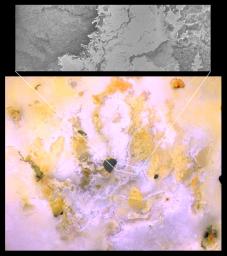
|
Bright Channelized Lava Flows on Io
- Click the image above for a larger view
- Full-Res JPEG (797 x 900) (115.7 kB)
- Full-Res TIFF (797 x 900) (1.6 MB)
Caption:
This image of Jupiter's moon Io, taken by NASA's Galileo spacecraft on November 25, 1999, shows a bright lava flow with a distinct dark channel in the middle. This type of winding channel is a common sight on shallow slopes in lava flows on Earth that are moving fairly quickly. The serrated margins are characteristic of fluid lava that is able to work its way into every available nook and crevice. What is unusual about this lava flow is its bright color -- most lava flows on Io and the other planets are dark. This leads Galileo scientists to speculate that these lava flows are composed of sulfur, rather than silicate rock. The lava flow appears to emanate from a caldera named Emakong, which is just beyond the left edge of the picture.
North is to the upper left of the picture and the Sun illuminates the surface from almost behind the spacecraft. The image, centered at -3.7degrees latitude and 117.4 degrees longitude, covers an area approximately 120 by 40 kilometers (75 by 25 miles). The resolution is 150 meters (500 feet) per picture element. The image was taken at a range of 15,000 kilometers (9,400 miles) by the camera onboard Galileo.
Background Info:
The Jet Propulsion Laboratory, Pasadena, CA manages the mission for NASA's Office of Space Science, Washington, DC. JPL is a division of the California Institute of Technology in Pasadena.
This image and other images and data received from Galileo are posted on the Galileo mission home page at http://solarsystem.nasa.gov/galileo/ . Background information and educational context for the images can be found at http://galileo.jpl.nasa.gov/gallery/io.cfm .
Cataloging Keywords:
| Name | Value | Additional Values |
|---|---|---|
| Target | Io | |
| System | Jupiter | |
| Target Type | Satellite | |
| Mission | Galileo | |
| Instrument Host | Galileo Orbiter | |
| Host Type | Orbiter | |
| Instrument | Solid-State Imaging (SSI) | |
| Detector | ||
| Extra Keywords | Color | |
| Acquisition Date | ||
| Release Date | 1999-12-17 | |
| Date in Caption | 1999-11-25 | |
| Image Credit | NASA/JPL/University of Arizona | |
| Source | photojournal.jpl.nasa.gov/catalog/PIA02518 | |
| Identifier | PIA02518 | |
